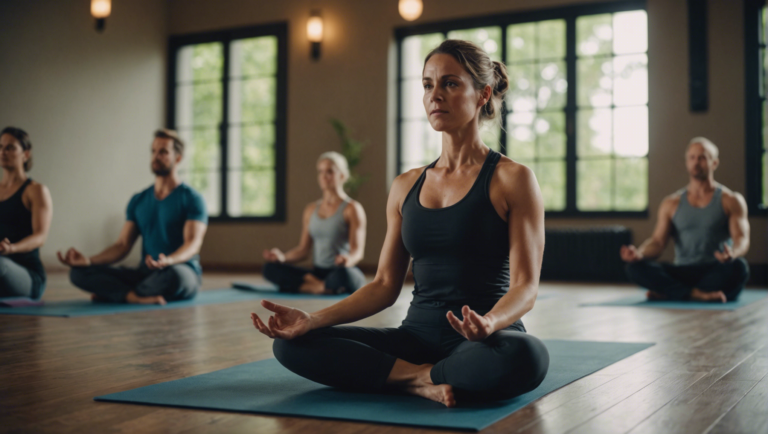Unveiling The Potential Downsides Of Yoga Practices
The Hidden Risks of Yoga: Beyond the Serenity
Yoga, with its origins dating back thousands of years, is widely celebrated for its physical, mental, and spiritual benefits. It’s often portrayed as a harmonious blend of exercises that promote serenity and well-being. However, beneath its serene facade, potential risks and challenges can emerge, particularly when practices are not appropriately adapted to individual needs. Understanding these risks is crucial for both seasoned practitioners and newcomers embarking on their yoga journey.
Examining the Physical Demands
The physical aspect of yoga, characterized by its diverse range of poses and movements, aims to enhance flexibility, strength, and balance. While these benefits are well-documented, the physical demands of certain poses can pose risks, especially for individuals with pre-existing conditions or those who push beyond their limits.
One of the critical areas of concern is the potential for injury. Common issues include muscle strains, joint stress, and, in more severe cases, ligament tears. Poses that involve extreme flexibility or strength, if not performed correctly or without proper guidance, can lead to acute or chronic injuries. Hence, a personalized approach, acknowledging individual limitations and incorporating modifications, is paramount to a safe practice.
The Psychological Angle
Yoga’s psychological benefits, such as stress reduction and enhanced mental clarity, are widely touted. Nevertheless, it’s important to recognize that yoga can also unearth deep-seated emotions or psychological discomfort for some individuals. For those dealing with trauma or mental health issues, certain practices, particularly those involving intense focus or meditation, can evoke distressing feelings or memories.
This aspect underscores the importance of a supportive and understanding environment, as well as the potential need for professional guidance when integrating yoga with mental health management. It highlights the necessity of mindfulness in practice, encouraging individuals to stay attuned to their emotional responses and to seek appropriate support when needed.
Potential for Misguided Practices
The proliferation of yoga through digital platforms, while beneficial in increasing accessibility, also raises concerns about the dissemination of incorrect or unsafe practices. Online tutorials may not offer the personalized adjustments or cautions a live instructor could provide, potentially leading practitioners into harmful routines.
Additionally, the commercialization of yoga has sometimes distorted its traditional principles, emphasizing physical aesthetics over holistic well-being. This shift can lead to a competitive mindset, pushing individuals to attempt advanced poses before they are physically or mentally ready, increasing the risk of injury or disillusionment with the practice.
Cultivating a Balanced Approach to Yoga
A balanced approach, emphasizing safety, personal limits, and the holistic essence of yoga, is crucial in mitigating these risks. Practitioners are encouraged to:
- Seek out qualified instructors who emphasize safe practices and offer modifications.
- Listen to their bodies, acknowledging the difference between beneficial discomfort and harmful strain.
- Remember the roots of yoga, focusing on the journey rather than the destination, to foster a practice that uplifts both body and mind.
Embracing Modifications and Gentle Practices
For many, the key to a sustainable and beneficial yoga practice lies in modifications and the incorporation of gentle practices. Restorative yoga, for example, focuses on relaxation and healing, using props to support the body in poses, reducing strain and the risk of injury. Similarly, adopting a mindful approach to yoga, recognizing when to push and when to rest, can prevent physical and mental burnout.
Final Thoughts
As yoga continues to evolve and touch the lives of millions worldwide, understanding its potential downsides is not an indictment of the practice but an invitation to engage with it more mindfully and safely. By acknowledging and addressing these risks, practitioners can fully embrace the profound benefits of yoga, ensuring a journey that is not only beneficial but sustainable and fulfilling in the long run.
The Role of Instructors in Mitigating Yoga Injuries
Yoga, a time-honored practice celebrated for its myriad health benefits, from enhancing flexibility to reducing stress, has seen a surge in popularity across the globe. However, as with any physical activity, it doesn’t come without its risks. Despite its gentle reputation, the potential for injury in yoga is real, particularly when practitioners are not guided correctly or push beyond their limits. In this light, the pivotal role of yoga instructors in safeguarding students against such injuries is ever more apparent. By emphasizing correct posture, personalized guidance, and the cultivation of body awareness, teachers can significantly mitigate the risks associated with yoga practice.
The Importance of Correct Posture
One of the foundational elements of safe yoga practice lies in the adherence to proper posture. Instructors are not merely guides but guardians of health, tasked with ensuring that each movement and pose is executed with precision. Misalignment, even in seemingly simple poses, can lead to strain and injury over time. This responsibility necessitates a profound understanding of human anatomy and a keen eye for detail on the part of the instructor. By offering real-time adjustments and feedback, they can protect their students from the pitfalls of incorrect form and foster a safer practice environment.
Personalized Guidance: Adapting Yoga to the Individual
Yoga inherently espouses a philosophy of individuality—acknowledging that every body is unique, with its own strengths and limitations. This recognition forms the cornerstone of injury prevention. Experienced instructors are adept at tailoring their sessions to accommodate the diverse needs of their students, offering modifications and alternative poses to ensure accessibility and safety. This personalized approach not only reduces the risk of injury but also enhances the overall efficacy and enjoyment of the practice. It speaks to the instructor’s ability to foster an inclusive environment where all students can thrive, irrespective of their experience level or physical capability.
Cultivating Body Awareness and Listening to Internal Cues
Beyond the physical mechanics of yoga, instructors play a crucial role in guiding their students towards a deeper understanding and connection with their bodies. This education goes hand in hand with teaching specific poses or breathing techniques. Cultivating body awareness encourages practitioners to heed their internal cues—recognizing the difference between a beneficial stretch and a harmful strain. Instructors empower their students to navigate their practice with mindfulness and discernment, thereby reducing the propensity for over-exertion and injury. This facet of instruction underscores the holistic nature of yoga, transcending mere physicality to embrace mental and emotional well-being.
Continuous Education and Professional Development for Instructors
The landscape of yoga is ever-evolving, with ongoing research shedding new light on best practices for safe instruction. In this context, the commitment of yoga instructors to continuous education and professional development is paramount. By staying abreast of new insights and methodologies, they can refine their teaching strategies to better protect their students. This pursuit of knowledge not only enriches their own practice but also elevates the standard of yoga instruction as a whole. It is a testament to their dedication to their students’ well-being and the integrity of the practice itself.
In essence, yoga instructors wield a significant influence over the safety and success of their students’ practice. Through a combination of meticulous posture guidance, personalized instruction, cultivation of body awareness, and a commitment to ongoing professional growth, they can markedly reduce the incidence of yoga-related injuries. Their role transcends mere instruction—it is one of mentorship, protection, and empowerment, ensuring that the journey of yoga remains not only fruitful but safe for all who embark upon it. Balancing the physical aspects of yoga with its mental and spiritual dimensions, instructors are the custodians of a practice that has the power to transform lives—provided it is approached with care and respect.
Yoga and Its Potential Impact on Pre-existing Health Conditions
Yoga, a practice rooted in ancient tradition, has surged in popularity as a holistic approach to health and wellness. Embraced by millions for its benefits on mental and physical well-being, yoga offers a refuge from the chaos of daily life, promoting peace, flexibility, and strength. However, it’s essential to acknowledge that yoga is not a one-size-fits-all solution, especially for individuals with pre-existing health conditions. Acknowledging the nuanced relationship between yoga and various health conditions is crucial for practitioners to navigate their wellness journey safely and effectively.
The Interplay Between Yoga and Physical Health Conditions
Yoga’s versatility offers adaptations for everyone, but without proper guidance and awareness, the physical practices can pose risks, especially for those with certain health conditions. For individuals with conditions such as herniated discs, high blood pressure, or severe arthritis, some yoga poses might exacerbate symptoms or lead to further injury. The key lies in understanding one’s body and limitations, seeking professional guidance, and approaching practice with mindfulness.
Navigating Yoga with Cardiovascular Concerns
Yoga’s impact on cardiovascular health is a double-edged sword. While many find yoga beneficial for reducing stress and lowering blood pressure, those with pre-existing cardiovascular conditions should proceed with caution. Practices involving intense poses or rapid sequences (such as in Vinyasa or Ashtanga yoga) can place strain on the heart. Conversely, gentler yoga styles may improve cardiovascular health without the risks associated with more vigorous practices.
Yoga and Its Effects on Mental Health
The mental health benefits of yoga are well-documented, offering a natural remedy for anxiety, depression, and stress. However, for individuals battling severe mental health issues, certain aspects of yoga, like deep meditation or pranayama (breath control), could potentially trigger adverse reactions without proper support or guidance. Personalizing one’s yoga practice to include therapeutic elements under the supervision of professionals is vital in these cases.
Structural Considerations and Injuries
The physical practice of yoga encourages strength, flexibility, and balance. However, pushing the body into poses it’s not ready for can lead to strains, sprains, and even more severe injuries. People with pre-existing musculoskeletal issues or those recovering from surgery should approach yoga with a tailored and therapeutic mindset, focusing on poses that aid recovery and enhance mobility without overexertion.
The Role of Professional Guidance
The importance of seeking the advice of healthcare professionals and certified yoga instructors cannot be overstated for individuals with pre-existing health conditions. A tailored yoga practice, designed with an awareness of one’s health issues, can provide the benefits of yoga safely. Professionals can help modify poses, suggest appropriate styles, and guide individuals in listening to their bodies to avoid potential risks.
Yoga: A Personal Journey
Yoga’s true essence lies in its adaptability and personal nature. Recognizing and respecting one’s limitations and health conditions paves the way for a fulfilling and safe practice. The journey involves learning and adapting, where the goal is not perfection but personal growth and well-being.
Understanding and Respect: The Path Forward
Embarking on a yoga practice with pre-existing health conditions requires an informed and respectful approach. By understanding the nuances of how yoga interacts with different health concerns, individuals can safely explore the vast world of benefits yoga offers. It’s about finding balance and harmony within one’s limitations, creating a practice that nurtures both body and mind.
Navigating the world of yoga with health concerns is a journey of self-awareness and education. With the right precautions, yoga can still be a valuable tool for enhancing quality of life, offering a path toward holistic health that respects the body’s limitations and embraces its potential.
The Psychological Downsides of Yoga Practices
Yoga is widely celebrated for its numerous benefits on physical health, mindfulness, and spiritual growth. However, like any practice, it comes with its own set of challenges, especially concerning psychological well-being. This article explores the nuanced dimensions of how yoga can inadvertently influence mental health, aiming to provide a comprehensive understanding beyond the often-idyllic portrayal of this ancient practice.
Exploring the Psychological Pressure of Self-Improvement
Yoga, at its core, is a discipline that encourages self-improvement and self-awareness. Practitioners are often on a perpetual quest for betterment, striving to achieve the perfect pose, the deepest meditation state, or a more profound spiritual connection. This relentless pursuit, however, may foster a counterproductive mindset. Participants might find themselves trapped in a cycle of self-criticism and dissatisfaction, where each session magnifies their perceived inadequacies instead of nurturing self-acceptance.
The Isolation of Personal Practice
Yoga is often a solitary activity, particularly for those who practice at home following online tutorials or in silence. While this can offer a valuable opportunity for quiet self-reflection, it may also lead to feelings of isolation and detachment from a support community. In the absence of a guided classroom environment or a shared practice, individuals might miss out on the beneficial aspects of social interaction and the motivational lift that comes from being part of a collective, potentially exacerbating feelings of loneliness and disconnection.
Comparisons and Competitive Mindset
Social media and the culture surrounding yoga can inadvertently encourage comparisons, where practitioners measure their progress against idealized representations of health, flexibility, and enlightenment. This comparison can breed feelings of inadequacy, jealousy, and a competitive mindset that stands in stark contrast to yoga’s foundational principles of inner peace and self-contentment. The relentless exposure to "perfect" bodies performing complex asanas (poses) can distort self-perception, leading to issues with body image and self-esteem.
Potential for Escapism and Avoidance
For some, yoga becomes a refuge to escape from unresolved issues, serving as a form of avoidance rather than a tool for confronting and coping with life’s challenges. Immersing oneself in practice can provide temporary relief, but it may also prevent individuals from addressing underlying psychological issues. When yoga serves as a band-aid solution rather than part of a holistic approach to mental health, it can contribute to the prolongation of personal problems.
Managing Expectations and Promoting Balance
The antidote to these psychological downsides lies in managing expectations and promoting a balanced approach to yoga. It is vital for practitioners to cultivate self-compassion, emphasizing progress over perfection. Encouraging a community-oriented practice can help counteract feelings of isolation, while mindfulness in consumption of social media and yoga content can alleviate the pressure of comparisons.
Nurturing a Healthy Mindset in Yoga Practice
Building a healthy relationship with yoga involves acknowledging its limitations and potential downsides. Practitioners should be encouraged to seek balance, integrating yoga with other forms of social and psychological support. Recognizing when yoga becomes a source of stress or negative self-talk is crucial. By fostering an environment of self-care, inclusivity, and realistic expectations, the practice can continue to be a source of strength and positivity.
As yoga continues to evolve in the West, it is imperative for both practitioners and instructors to remain mindful of its complex impact on psychological well-being. By addressing the challenges head-on, the yoga community can ensure that the practice remains a supportive, enriching, and uplifting part of individuals’ lives, truly honoring its holistic potential.
Balancing the Benefits and Risks: A Comprehensive View of Yoga
Yoga, an ancient practice originating from India, has surged in popularity globally due to its purported benefits on physical and mental health. Rooted in spiritual traditions, it has evolved into various forms, from the meditative and relaxing to the physically demanding. As a holistic discipline, it offers a wealth of benefits, including improved flexibility, strength, and stress reduction. However, acknowledging and understanding the potential downsides is equally important to ensure a balanced approach to practice. This article delves into both sides to present a comprehensive view.
Exploring Yoga’s Multifaceted Benefits
Yoga’s appeal lies in its versatility and accessibility, catering to a wide demographic. Its benefits are well-documented, ranging from physical to psychological. Practitioners often report enhanced muscle tone, better posture, and increased flexibility. These physical improvements are noticeable and measurable, making yoga an attractive option for those looking to improve their physical health without the high impact of other exercise forms.
Beyond physical health, mental well-being is markedly improved for many who practice yoga regularly. Techniques such as mindfulness and controlled breathing are integral parts of yoga, helping to alleviate stress and anxiety. This mind-body connection fosters a deep sense of peace and relaxation, contributing to improved mental health outcomes.
Recognizing Potential Physical Risks
Despite its many benefits, yoga is not without its risks, particularly when it comes to physical health. Injuries can occur, often due to improper practice or attempting advanced poses without adequate preparation or guidance. The risk of strain or overstretching can lead to muscle tears, joint injuries, or worse. These risks underscore the importance of practicing with a qualified instructor and listening to one’s body to avoid pushing beyond safe limits.
Additionally, certain health conditions may be exacerbated by yoga practices. For example, individuals with pre-existing conditions like herniated discs or high blood pressure may find that certain poses can aggravate their symptoms. Therefore, consulting with a healthcare provider before beginning a yoga regimen is crucial, especially for those with known health issues.
The Psychological Impact: Not Always Positive
While yoga is often praised for its mental health benefits, it’s important to note that the experience is not universally positive. Some individuals may find that the introspective and solitary nature of the practice can amplify feelings of isolation or introspection in an unhelpful way. Furthermore, the pressure to perform or progress in practice can lead to frustration or decreased self-esteem for some, counteracting the positive psychological benefits.
Navigating the Landscape of Commercialization
The rapid growth of yoga’s popularity has led to its commercialization, with a market inundated with classes, retreats, and merchandise. This commercial aspect can sometimes distort yoga’s authentic principles, prioritizing profit over genuine practice and potentially alienating those seeking its original spiritual and holistic benefits. It raises questions about the dilution of yoga’s essence and the implications for practitioners seeking authenticity.
Embracing a Balanced Approach to Yoga Practice
For individuals considering yoga or those already practicing, a balanced approach is key. It involves being informed about both the benefits and potential downsides, acknowledging personal limits, and seeking professional advice when necessary. Selecting the right type of yoga and instructor can also make a significant difference in the experience and outcomes of the practice.
In essence, yoga offers profound benefits for many, but like any physical or mental health regimen, it comes with caveats. Awareness and mindfulness, both central tenets of yoga, are crucial in navigating its practice safely and beneficially. By considering the full spectrum of yoga’s impact, practitioners can fully enjoy its benefits while minimizing risks, leading to a healthier, more balanced life.
Conclusion
Yoga, with its ancient roots and modern popularity, often appears as an emblem of tranquility and wellness. Yet, as we’ve explored, beneath the serene surface lie hidden risks that practitioners and enthusiasts would do well to acknowledge. The exploration of these aspects not only demystifies yoga but also provides a balanced perspective on a practice that has become a global phenomenon.
The journey into the lesser-known territories of yoga brings to light the paradox that exists within its practice. While injury is not what one typically associates with this seemingly gentle endeavor, the potential for harm is real, highlighting a crucial aspect often overlooked by many. The responsibility of instructors in this regard cannot be overstated. Their role transcends the mere teaching of poses and extends into safeguarding the well-being of their students through tailored guidance that respects individual limitations and challenges. This stewardship is essential in creating an environment where the benefits of yoga can be enjoyed without the shadow of injury.
Further complicating the landscape are pre-existing health conditions that can either be alleviated or exacerbated by yoga. The intricate dance between body and practice underscores the need for a nuanced approach, where yoga is not seen as a panacea but as a component of holistic well-being that requires careful consideration and adaptation. This understanding is pivotal in harnessing the healing potential of yoga while minimizing its risks.
On the psychological front, yoga’s impact is a double-edged sword. The mental and emotional journey it initiates can lead to profound internal discoveries and transformations. However, it can also stir unsettling emotions and psychological states, an aspect that is less frequently discussed. Acknowledging and addressing these potential psychological downsides ensures that individuals approach their practice with mindfulness, making space for emotional processing and seeking professional guidance when needed.
Balancing the benefits and risks of yoga necessitates a comprehensive view that embraces the full spectrum of its effects on the human experience. It involves recognizing that like any significant practice, yoga requires respect, awareness, and a thoughtful approach. This balanced perspective does not diminish yoga’s value but rather enhances its practice by fostering informed decisions that align with personal health and psychological well-being.
The discussion around the potential downsides of yoga serves not as a deterrent but as a call for a more informed, cautious, and personalized practice. It is a reminder that yoga, in its essence, is a journey of self-discovery and personal growth that is both physical and spiritual. This journey should be approached with care, a deep understanding of one’s body and mind, and a commitment to practicing safely under the guidance of knowledgeable instructors.
By illuminating the risks alongside the benefits, this exploration encourages a dialogue within the yoga community and among individuals drawn to the practice. It advocates for an evolutionary approach to yoga that honors its traditions while adapting to contemporary understanding of health and wellness. In this way, yoga can continue to be a source of strength, flexibility, and peace for many, provided it is practiced with a holistic awareness of its potential impacts.
As individuals navigate their path through yoga, they may find that the most significant lessons emerge not from achieving the perfect pose but from listening to their body and respecting its limits. This humility and attentiveness pave the way for a practice that is not only physically fulfilling but also spiritually enriching and psychologically grounding. Thus, with careful consideration and a balanced approach, yoga can indeed be a conduit for profound personal transformation and well-being.






